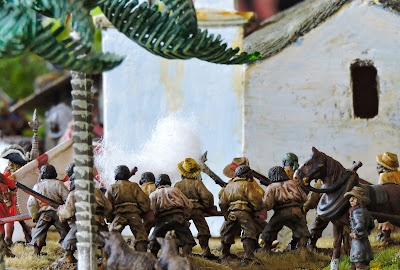 |
| Creole infantry in action! |
The Caribbean theatre started as a one off idea but the more I researched it the more I got hooked by the scope, scale and generally bizarre nature of what the European superpowers got up to there.
Our first outing centres on Jamaica - previously Spanish, now English and very recently declared for King James and not King William. Challenging possession of the island is an unholy alliance between the displaced Spaniards, now operating from the much larger territory of Cuba and their Protestant allies - the Huguenots and a distinctly commercial concern the NGWIC (new Dutch West India Company)
This post is about the forces and not the action so here they are with a little explanation of each on the way:
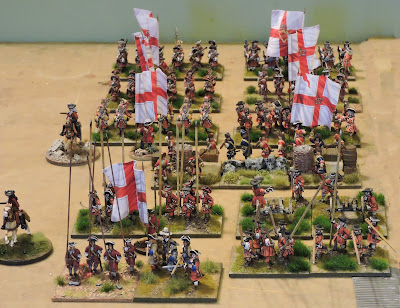 |
| General Dominic Sheldon's Irish Expeditionary Regiment of Foot |
Sheldon's Irish Regiment is a composite force of ten companies drawn from the regiments in England and Ireland. There are three pike companies (how useful this weapon would be in the Indies remains to be seen), five musketeer companies, one oversized grenadier company and an independent fuzileer company. Two light guns accompanied the force. The commander is Englishman, devout Catholic and loyal servant of King James - Dominic Sheldon. Total compliment 650 men.
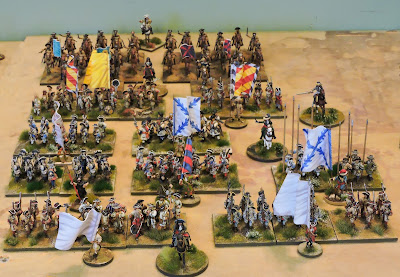 |
| General Torres Spanish Force from Cuba |
The Spaniards want Jamaica back. King Carlos has agreed to support the Williamite invasion in order to win a chance of regaining the island )although how this is to be achieved is not certain). The Spanish force is composed of experienced Tropical service soldiers from the Cartagena Tercio. Six musketeer companies and one pike company are drawn from this regular formation. In addition, Torres has brought a body of 60 cuirassiers under Don Ramon and a further 60 volunteer Horse. Since Jamaica was Spanish until relatively recently many Spanish born men on the island have rallied to a secret call to arms producing two large units of Spanish- Jamaican militia amounting to over 200 men. The Spaniards also have two large field cannons. The total Spanish force exceeds 740 men.
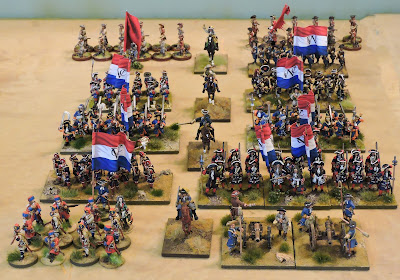 |
| NGWIC Forces - Dutch West India Company troops out of Sint Maarten. |
I looked into the Dutch West India Company a little. I did not find definitive military organizational information but I assumed a military presence and put together seven companies of musketeers, one of Grenadiers, two volunteer companies of Protestant Irish Planters who will not swear fealty to King James and two light guns. In command of the force is the Scottish aristocrat Lord George Hamilton, recently commander of Enniskillen forces in England. The destruction of his command at Ripon was rewarded with a large shareholding in the Dutch India Company and an immediate posting to supervise military operations in the Caribbean where King William wished to open a new front. Clarence kindly created the flags which are the genuine design. I had high hopes for these Dutchmen.
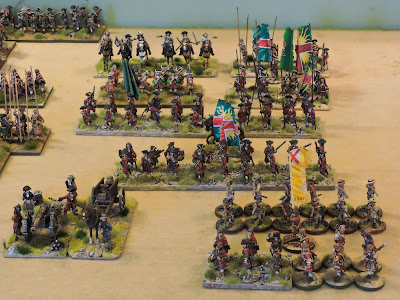 |
| Governor Kirke's Lambs - used to the heat after Tangier |
General Piercy Kirke, controversial, blunt, combative, corrupt, brutal, coarse (and these are only some of the complementary adjectives used to describe him!) has escaped two murder attempts to be promoted to Governor of Jamaica. He has been able to take with him most of his veteran regiment, The Lambs. His force contains four companies of musketeers one of grenadiers and two of pikemen. These are supported by two volunteer companies of Irish Catholic Planters from Jamaica, one troop of volunteer gentlemen planter cavalry and a very large field piece called 'Long Sal'.
 |
| Colonel Hylton's Creole Regiment and Jamaican volunteers |
The English had Creole regiments in the Caribbean. One such is led by Bartholomew Hylton. The regiment has six companies of matchlock armed musketeers. In addition, Jamaica has raised the militias of Port Royal and Spanish Town together with citizen volunteers from both settlements. The army had sent selected grenadiers to form a composite company of English elite troops. Further support came from three troops of volunteer Horse drawn from plantation owners and workers. Local fortifications had several naval guns available. There were nearly 800 men in the Jamaican force.
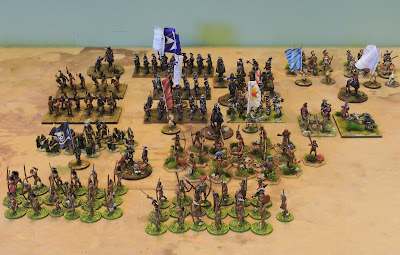 |
| Le Marquis de Ruvigny's Huguenot and Native force |
The French Huguenot Marquis de Ruvigny has been sent to the Caribees by King William but the motivation is not totally clear. a core of Huguenot regulars is the heart of the force but there are several unusual elements including Huguenot planters from Martinique and Gualdeloupe, Haitian Freemen who belong to some sort of cult known as Kil nan lanmò (Haitian Creole), several groups of Maroons( freed or escape English slaves) known as the Warria and Smuggla and small bands of Tainu natives from Jamaica and surrounding islands. This force created some of the most interesting, weird and comic incidents of the invasion.
